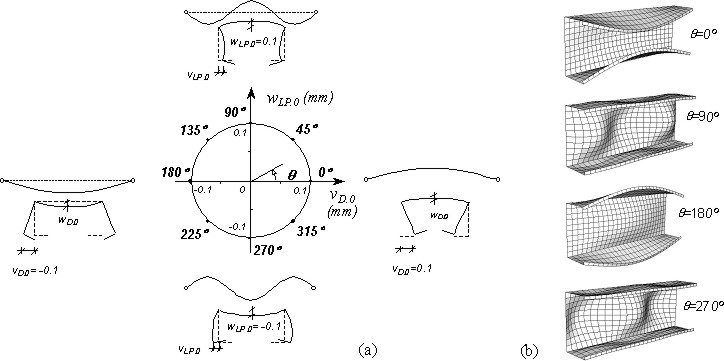
engineering & technology publications
ISSN 1759-3433
PROCEEDINGS OF THE TENTH INTERNATIONAL CONFERENCE ON CIVIL, STRUCTURAL AND ENVIRONMENTAL ENGINEERING COMPUTING
Analysis of Local-Plate/Distortional Mode Interaction in Cold-Formed Steel Lipped Channel Columns
Department of Civil Engineering and Architecture, Instituto Superior Técnico, Technical University of Lisbon, Portugal
The aim of this paper is to present and discuss the results of a numerical investigation
dealing with the influence of local-plate/distortional buckling mode interaction on the
elastic and elastic-plastic post-buckling behaviour and strength of lipped channel
cold-formed steel columns. The columns analysed exhibit (i) cross-section dimensions and
length values that ensure equal local-plate and distortional critical stresses, (ii) several
yield-to-critical stress ratios and (iii) locally/globally pinned free-to-warp end sections.
Moreover, since the main goal of this work is to assess the local-plate/distortional mode
interaction effects, one must determine the post-buckling behaviour of columns with
a wide variety of critical-mode initial imperfection shapes, all sharing the same overall
amplitude. In this work, the initial imperfection shapes combine the three-wave local-plate
and single-wave distortional critical buckling modes, multiplied by amplitudes ![]() and
and ![]() that are appropriately chosen to ensure an overall magnitude equal to 10% of
the wall thickness
that are appropriately chosen to ensure an overall magnitude equal to 10% of
the wall thickness ![]() (see Figure 152.1).
(see Figure 152.1).
The analyses were performed using mostly the finite element method (code ABAQUS with columns discretised by means of fine meshes of 4-node shell elements), but also a recently developed and numerically implemented generalised beam theory (GBT) formulation, which includes shear and transverse extension deformation modes (only elastic results). The results presented and discussed consist of (i) elastic and elastic-plastic post-buckling equilibrium paths, (ii) curves describing the evolution, along the elastic paths, of the column deformed configurations and (iii) figures providing information about the effect of the initial imperfection shape on the spread of plasticity and column elastic-plastic failure mode (see Figure 152.2).
Among the conclusions drawn from this investigation, it is worth mentioning: (i) in
the advanced post-buckling stages, all the elastic and elastic-plastic equilibrium paths
"merge" into two curves, associated with predominantly distortional coupled modes; (ii)
when the imperfection is predominantly local-plate, a "snap-through" occurs along the
column elastic equilibrium path; (iii) in the GBT-based post-buckling analyses, it is more
meaningful to view the initial imperfections as combinations of deformation modes; (iv)
in spite of the fairly good qualitative agreement between the finite element method (FEM) and GBT-based
elastic post-buckling results, some quantitative differences remain to be explained; (v)
the elastic-plastic failure may be triggered by the onset of yielding (low-to-moderate
![]() ) or preceded by a "snap-through" phenomenon and a subsequent strength increase
(high
) or preceded by a "snap-through" phenomenon and a subsequent strength increase
(high
![]() ) and (vi) the pure distortional initial imperfections are the most detrimental
ones - they correspond to the lowest column strengths (elastic or elastic-plastic).
) and (vi) the pure distortional initial imperfections are the most detrimental
ones - they correspond to the lowest column strengths (elastic or elastic-plastic).

|

|
purchase the full-text of this paper (price £20)
go to the previous paper
go to the next paper
return to the table of contents
return to the book description
purchase this book (price £135 +P&P)